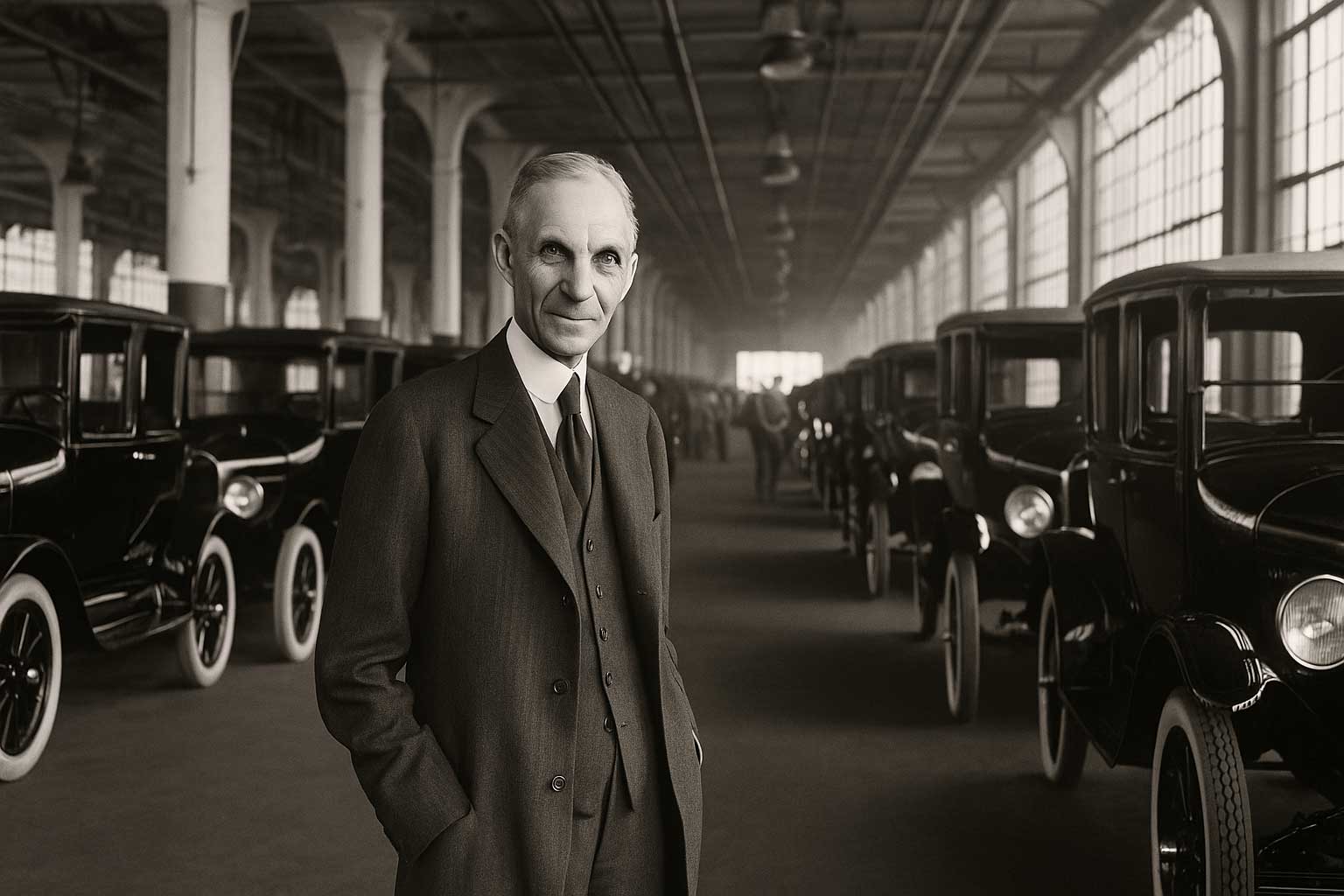Henry Ford’s Impact on Global Industry
Henry Ford didn’t just build cars, he built the playbook. Before him, factories were chaotic, labor was unstable, and production was slow. After him? The world knew how to scale. The moving assembly line wasn’t a tweak; it was a revolution. Suddenly, mass production wasn’t just possible, it was inevitable. His model was copied from Detroit to Tokyo to Berlin. Every major industrial economy of the 20th century owes part of its rise to Ford’s system. Whether you’re building Teslas or turbines, the bones of that process still look a lot like Henry’s original vision: scale fast, build cheap, own the process.
Born: July 30, 1863 — Died: April 7, 1947
Key Stats
| Metric | Value |
| Model T production | 15 million units (1908–1927) |
| Assembly line wage | $5/day (1914) |
| Global factories | Operating across 6 continents by 1929 |
| War production | 9,000 B‑24 bombers from Willow Run plant |
Henry Ford revolutionized the way the world moved. Here’s a breakdown of the man, his methods, and the scale of his impact:
- First vehicle: Completed his Quadricycle in 1896—the foundation of a global empire
- Founded Ford Motor Company: 1903, with just $28,000 in capital
- Launched the Model T: 1908, priced at $825 at debut then slashed to $360 by 1916. By 1918, half of US cars were Model Ts
Henry Ford’s Factory Innovation & Worker Welfare
- Introduced moving assembly lines in 1913—production soared from 250,000 units (1914) to 472,000 (1916)
- Pioneered the $5/day wage in 1914, more than doubling typical wages—cut turnover, boosted productivity, and broadened the consumer base.
- Merged extreme efficiency with welfare capitalism—flat hierarchy, profit-sharing, but also paternalistic oversight.

Global Industrial Reach
- Built plants across six continents (UK, Germany, Australia, India, Brazil, Canada) by 1929—one-third of global auto output came from Ford
- Experimented with Fordlândia (Amazon rubber plantation)—an industrial misstep, but showing his global ambition
Diversifying into Aviation & War Efforts
- Produced Liberty engines and 1st-ever U.S. passenger airliner, the Model 4-AT Trimotor (“Tin Goose”) in 1926
- Willow Run plant during WWII: turned out 9,000 B‑24 bombers—one every 58 minutes
Complex Legacy
- A celebrated innovator whose anti-Semitic views and support for isolationist politics tainted Henry Ford’s reputation.
- His methods and outspoken views remain subjects of debate—yet his industrial model still defines mass production.
The Ford Legacy: Bloodlines and Business
When Henry Ford died in 1947, his empire didn’t just pass to a board—it passed to his bloodline. But Ford’s belief in control meant his son, Edsel Ford, never really got to run free. Edsel, more refined and design-oriented, clashed with his father’s obsession for function over form. After Edsel’s death, the company cycled through family hands—Henry Ford II took over at just 28 and became the man who modernized the company. He cleaned house, hired professionals, and turned Ford from a founder-led empire into a corporate machine.
But even today, the Ford family still controls 40% of voting shares. That’s legacy with teeth. Henry didn’t just build a business—he built a dynasty. You don’t stay in power that long without learning how to play both sides: the boardroom and the bloodline. And that’s why the Ford name still matters—not just in Detroit, but globally.
Why Henry Ford Belongs in the Hall of Fame

Henry Ford didn’t just build cars—he built society. He:
- Democratized mobility by making cars affordable for the masses.
- Pioneered modern manufacturing—his assembly line model became a global standard.
- Took care of his workforce, believing employees should afford the products they made.
- Created an industrial empire that shaped economies, war efforts, and consumer culture.
Back to the Business Founders Hall of Fame
Want to see how Ford stacks up against the other titans? The Business Founders Hall of Fame is where legacy meets impact. We break down how the world’s most ambitious entrepreneurs built empires that didn’t just survive history—they wrote it. From Rockefeller’s ruthless efficiency to Tata’s nation-building vision, this is the league where Ford belongs. Go deeper and explore how each founder changed their industry—and what that means for you as a builder today.






